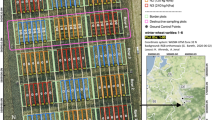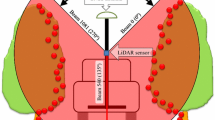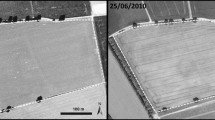Abstract
The adoption of precision agriculture involves a demand for equipment and solutions to create an accurate diagnostic of the spatial variability to be managed at the field level. Sugarcane has faced some challenges due to the limited solutions adapted to the crop, which develops throughout the year and involving a large-scale harvest. LiDAR (Light Detection and Ranging) technology is a high-resolution tool that permits the measurement of vegetative growth in a non-destructive way, assisting, for example, in harvest planning. The objective was to describe the three-dimensional (3D) data processing to characterize the spatial variability of sugarcane fields in the pre-harvest period. An aerial platform was used for data acquisition 10 days before and after harvesting. The digital models of surface, of terrain, and the canopy height model (CHM) were generated to spatialize plants height based on point cloud. The LiDAR-derived metrics extracted were percentiles (P50th; P90th–P99th), with the highest value of the coefficient of variation observed for the P50th (59%), indicating that there is high spatial variability in plant height. The RMSE (Root Mean Squared Error) among field measurements and sugarcane stalk height from CHM was 0.47 m. This study demonstrates that 3D sensing data can provide relevant information for the assessment of the crop height and, potentially, to consider it as an indicator of the field regions with distinct levels of production.






Similar content being viewed by others
References
Bareth, Georg, Juliane Bendig, Nora Tilly, Dirk Hoffmeister, Helge Aasen, and Andreas Bolten. 2016. A Comparison of UAV and TLS-derived Plant Height for Crop Monitoring: Using Polygon Grids for the Analysis of Crop Surface Models (CSMs). Photogrammetrie, Fernerkundung, Geoinformation. 2: 85–94. https://doi.org/10.1127/pfg/2016/0289.
Bazezew, M.N., Y.A. Hussin, and E.H. Kloosterman. 2018. Integrating airborne LiDAR and terrestrial laser scanner forest parameters for accurate above-ground biomass/carbon estimation in Ayer Hitam tropical forest, Malaysia. International Journal of Applied Earth Observation and Geoinformation 73: 638–652. https://doi.org/10.1016/j.jag.2018.07.026.
Bégué, Agnes, V. Lebourgeois, E. Bappel, P. Todoroff, A. Pellegrino, F. Baillarin, and B. Siegmund. 2010. Spatio-temporal variability of sugarcane fields and recommendations for yield forecast using NDVI. International Journal of Remote Sensing 31 (20): 5391–5407. https://doi.org/10.1080/01431160903349057.
Brocks, Sebastian, and Georg Bareth. 2018. Estimating barley biomass with crop surface models from oblique RGB imagery. Remote Sensing 10 (2): 268. https://doi.org/10.3390/rs10020268.
Buelvas, Roberto M., Viacheslav I. Adamchuk, Eko Leksono, Peter Tikasz, Mark Lefsrud, and Jarek Holoszkiewicz. 2019. Biomass estimation from canopy measurements for leafy vegetables based on ultrasonic and laser sensors. Computers and Electronics in Agriculture 164: 104896. https://doi.org/10.1016/j.compag.2019.104896.
Canata, Tatiana Fernanda, José P. Molin, and Rafael Vieira de Sousa. 2019. A measurement system based on LiDAR technology to characterize the canopy of sugarcane plants. Engenharia Agrícola 39 (2): 240–247. https://doi.org/10.1590/1809-4430-eng.agric.v39n2p240-247/2019.
Borra-Serrano, Irene, Tom De Swaef, Hilde Muylle, David Nuyttens, Jürgen. Vangeyte, Koen Mertens, Wouter Saeys, Ben Somers, Isabel Roldán-Ruiz, and Peter Lootens. 2019. Canopy height measurements and non-destructive biomass estimation of Lolium perenne swards using UAV imagery. Grass Forage Science 74: 356–369. https://doi.org/10.1111/gfs.12439.
Cholula, Uriel, Jorge A. da Silva, Thiago Marconi, J Alex Thomasson, J. Solorzano, and J. Enciso. 2020. Forecasting yield and lignocellulosic composition of energy cane using unmanned aerial systems. Agronomy 10 (5): 718. https://doi.org/10.3390/agronomy10050718.
Mesas-Carrascosa, Francisco-Javier., Ana I. de Castro, Jorge Torres-Sánchez, Paula Triviño-Tarradas, Francisco M. Jiménez-Brenes, Alfonso García-Ferrer, and Francisca López-Granados. 2020. Classification of 3D Point Clouds Using Color Vegetation Indices for Precision Viticulture and Digitizing Applications. Remote Sensing 12: 317. https://doi.org/10.3390/rs12020317.
Colaço, André Freitas., José Paulo. Molin, Joan R. Rosell-Polo, and Alexandre Escolà. 2018. Application of light detection and ranging and ultrasonic sensors to high-throughput phenotyping and precision horticulture: current status and challenges. Horticulture Research 5: 35. https://doi.org/10.1038/s41438-018-0043-0.
Colaço, André Freitas., José Paulo. Molin, Joan R. Rosell-Polo, and Alexandre Escolà. 2019. Spatial variability in commercial orange groves. Part 1: canopy volume and height. Precision Agriculture 20: 788–804. https://doi.org/10.1007/s11119-018-9612-3.
Silva, Carlos Alberto, Andrew Thomas Hudak, Carine Klauberg, Lee Alexandre Vierling, Carlos Gonzalez-Benecke, Samuel de Padua, Chaves Carvalho, Luiz Carlos Estraviz. Rodriguez, and Adrián Cardil. 2017. Combined effect of pulse density and grid cell size on predicting and mapping aboveground carbon in fast-growing Eucalyptus forest plantation using airborne LiDAR data. Carbon Balance and Management 12 (13): 1–16. https://doi.org/10.1186/s13021-017-0081-1.
CONAB. Companhia Nacional de Abastecimento. https://www.conab.gov.br/info-agro/safras/cana/boletim-da-safra-de-cana-de-acucar
da Cunha, Antonio Ribeiro, and Dinival Martins. 2009. Classificação climática para os municípios de Botucatu e São Manuel, SP. Irriga 14 (1): 1–11. https://doi.org/10.15809/irriga.2009v14n1p1-11.
Eitel, Jan, Troy S. Magney, Lee A. Vierling, Tabitha Brown, and David R. Huggins. 2014. LiDAR based biomass and crop nitrogen estimates for rapid, non-destructive assessment of wheat nitrogen status. Field Crops Research 159: 21–32. https://doi.org/10.1016/j.fcr.2014.01.008.
Escolà, Alexandre, José A. Martínez-Casasnovas, Josep Rufat, Jaume Arnó, Amadeu Arbonés, Francesc Sebé, Miquel Pascual, Eduard Gregorio, and Joan R. Rosell-Polo. 2016. Mobile terrestrial laser scanner applications in precision fruticulture/horticulture and tools to extract information from canopy point clouds. Precision Agriculture 18: 111–132. https://doi.org/10.1007/s11119-016-9474-5.
Li, Penglei, Xiao Zhang, Wenhui Wang, Hengbiao Zheng, Xia Yao, Yongchao Tian, Yan Zhu, Weixing Cao, Qi. Chen, and Tao Cheng. 2020. Estimating aboveground and organ biomass of plant canopies across the entire season of rice growth with terrestrial laser scanning. International Journal of Applied Earth Observation and Geoinformation 91: 102132. https://doi.org/10.1016/j.jag.2020.102132.
Friedli, Michael, Norbert Kirchgessner, Christoph Grieder, Frank Liebisch, Michael Mannale, and Achim Walter. 2016. Terrestrial 3D laser scanning to track the increase in canopy height of both monocot and dicot crop species under field conditions. Plant Methods. https://doi.org/10.1186/s13007-016-0109-7.
Gebremedhin, Alem, Pieter E. Badenhorst, Junping Wang, German C. Spangenberg, and Kevin F. Smith. 2019. Prospects for measurement of dry matter yield in forage breeding programs using sensor technologies. Agronomy 9 (2): 65. https://doi.org/10.3390/agronomy9020065.
Luciano, Ana Cláudia, Michelle dos Santos, Cristina Araújo Picoli, Jansle Vieira Rocha, Henrique Coutinho Junqueira. Franco, Guilherme Martineli Sanches, Manoel Regis Lima Verde. Leal, and Guerric le Maire. 2018. Generalized space-time classifiers for monitoring sugarcane areas in Brazil. Remote Sensing of Environment 215: 438–451. https://doi.org/10.1016/j.rse.2018.06.017.
Gomes, Frederico Pimentel, and Carlos Henrique Garcia. 2002. Estatística aplicada a experimentos agronômicos e florestais. Piracicaba: FEALQ.
Gorgens, Eric Bastos, Ruben Valbuena, and Luiz Carlos Estraviz. Rodriguez. 2017. A method for optimizing height threshold when computing airborne laser scanning metrics. Photogrammetric Engineering & Remote Sensing 83 (5): 343–350. https://doi.org/10.14358/PERS.83.5.343.
Hämmerle, Martin, and Bernhard Höfle. 2014. Effects of reduced terrestrial LiDAR point density on high-resolution grain crop surface models in precision agriculture. Sensors 14 (12): 24212–24230. https://doi.org/10.3390/s141224212.
ten Harkel, Jelle, Harm Bartholomeus, and Lammert Kooistra. 2020. Biomass and crop height estimation of different crops using UAV-based lidar. Remote Sensing 12 (1): 17. https://doi.org/10.3390/rs12010017.
Holman, Fenner H., Andrew B. Riche, Adam Michalski, March Castle, Martin J. Wooster, and Malcolm J. Hawkesford. 2016. High throughput field phenotyping of wheat plant height and growth rate in field plot trials using UAV based remote sensing. Remote Sensing 8 (12): 1031. https://doi.org/10.3390/rs8121031.
Hopkinson, Chris, Jenny Lovell, Laura Chasmer, David Jupp, Natascha Kljun, and Eva van Gorsel. 2013. Integrating terrestrial and airborne lidar to calibrate a 3D canopy model of effective leaf area index. Remote Sensing of Environment 136: 301–314. https://doi.org/10.1016/j.rse.2013.05.012.
da Silva, Vanessa Sousa, C.A. Silva, M. Mohan, A. Cardil, F.E. Rex, G.H. Loureiro, D.R.A.D. Almeida, E.N. Broadbent, E.B. Gorgens, A.P. Dalla Corte, and E.A. Silva. 2020. Combined impact of sample size and modeling approaches for predicting stem volume in eucalyptus spp. forest plantations using field and LiDAR data. Remote Sensing 12 (9): 1438. https://doi.org/10.3390/rs12091438.
Jiang, Yu., Changying Li, Fumiomi Takeda, Elizabeth A. Kramer, Hamid Ashrafi, and Jamal Hunter. 2019. 3D point cloud data to quantitatively characterize size and shape of shrub crops. Horticulture Research. https://doi.org/10.1038/s41438-019-0123-9.
Jimenez-Berni, Jose A., Deery M. Deery, Pablo Rozas-Larraondo, Anthony Tony Condon, Greg J. Rebetzke, Richard A. James, William D. Bovill, Robert T. Furbank, and Xavier R. Sirault. 2018. High throughput determination of plant height, ground cover, and above-ground biomass in wheat with LiDAR. Frontiers in Plant Science 9: 237. https://doi.org/10.3389/fpls.2018.00237.
Li, Wang, Zheng Niu, Hanyue Chen, and Dong Li. 2017. Characterizing canopy structural complexity for the estimation of maize LAI based on ALS data and UAV stereo images. International Journal of Remote Sensing 38 (8): 2106–2116. https://doi.org/10.1080/01431161.2016.1235300.
Roussel, Jean-Romain, David Auty, Florian De Boissieu, Andrew Sánchez Meador. 2019. lidR: Airborne LiDAR data manipulation and visualization for forestry applications - version 2.0.2.
Loudermilk, Louise E., J. Kevin Hiers, Joseph J. O’Brien, Robert J. Mitchell, Abhinav Singhania, Juan C. Fernandez, Wendell P. Cropper Jr, and K. Clint Slatton. 2009. Ground-based LIDAR: A novel approach to quantify fine-scale fuelbed characteristics. International Journal of Wildland Fire 18: 676–685. https://doi.org/10.1071/WF07138.
Luo, Shezhou, Jing M. Chen, Cheng Wang, Xiaohuan Xi, Hongcheng Zeng, Dailiang Peng, and Dong Li. 2016. Effects of LiDAR point density, sampling size and height threshold on estimation accuracy of crop biophysical parameters. Optics Express 24 (11): 11578–11593. https://doi.org/10.1364/OE.24.011578.
Maes, Wouter H., and Kathy Steppe. 2019. Perspectives for remote sensing with unmanned aerial vehicles in precision agriculture. Trends in Plant Science 24 (2): 152–164. https://doi.org/10.1016/j.tplants.2018.11.007.
Maimaitijiang, Maitiniyazi, Vasit Sagan, Paheding Sidike, Sean Hartling, Flavio Esposito, and Felix B. Fritschi. 2020. Soybean yield prediction from UAV using multimodal data fusion and deep learning. Remote Sensing of Environment. https://doi.org/10.1016/j.rse.2019.111599.
Wang, Ming, Zhengjia Liu, Muhammad Hasan Ali. Baig, Yongsheng Wang, Yurui Li, and Yuanyan Chen. 2019. Mapping sugarcane in complex landscapes by integrating multi-temporal Sentinel-2 images and machine learning algorithms. Land Use Policy 88: 104190. https://doi.org/10.1016/j.landusepol.2019.104190.
Mielcarek, Mi.łosz, Krzysztof Stereńczak, and Anahita Khosravipour. 2018. Testing and evaluating different LiDAR-derived canopy height model generation methods for tree height estimation. International Journal of Applied Earth Observation and Geoinformation 71: 132–143. https://doi.org/10.1016/j.jag.2018.05.002.
Mielcarek, Milosz, Agnieszka Kamińska, and Krzysztof Stereńczak. 2020. Digital aerial photogrammetry (DAP) and airborne laser scanning (ALS) as sources of information about tree height: Comparisons of the accuracy of remote sensing methods for tree height estimation. Remote Sensing 12 (11): 1808. https://doi.org/10.3390/rs12111808.
Molijn, Ramses A., Lorenzo Iannini, Jansle Vieira Rocha, and Ramon F. Hanssen. 2018. Ground reference data for sugarcane biomass estimation in São Paulo state, Brazil. Science Data 5 (180150): 1–18. https://doi.org/10.1038/sdata.2018.150.
Molin, José Paulo., André Freitas. Colaço, and Amaral do Lucas Rios . 2015. Agricultura de precisão, 1st ed. Piracicaba: Oficina de Textos.
Tilly, Nora, Dirk Hoffmeister, Qiang Cao, Shanyu Huang, Victoria Lenz-Wiedemann, Yuxin Miao, and Georg Bareth. 2014. Multitemporal crop surface models: accurate plant height measurement and biomass estimation with terrestrial laser scanning in paddy rice. Journal of Applied Remote Sensing 8 (1): 083671. https://doi.org/10.1117/1.JRS.8.083671.
Murray, Jon, Joseph T. Fennell, George Alan Blackburn, James Duncan Whyatt, and Bo. Li. 2020. The novel use of proximal photogrammetry and terrestrial LiDAR to quantify the structural complexity of orchard trees. Precision Agriculture 21: 473–483. https://doi.org/10.1007/s11119-019-09676-4.
Okhrimenko, Maxim, Craig Coburn, and Chris Hopkinson. 2019. Multi-spectral lidar: Radiometric calibration, canopy spectral reflectance, and vegetation vertical SVI profiles. Remote Sensing 11 (13): 1556. https://doi.org/10.3390/rs11131556.
Paulus, Stefan, Jan Behmann, Anne-Katrin. Mahlein, Lutz Plümer, and Heiner Kuhlmann. 2014. Low-cost 3D systems - well suited tools for plant phenotyping. Sensors 14 (2): 3001–3018. https://doi.org/10.3390/s14020300.
Paulus, Stefan. 2019. Measuring crops in 3D: Using geometry for plant phenotyping. Plant Methods 15: 103. https://doi.org/10.1186/s13007-019-0490-0.
Poley, Lucy G., and Gregory J. McDermid. 2020. A systematic review of the factors influencing the estimation of vegetation aboveground biomass using unmanned aerial systems. Remote Sensing 12 (7): 1052. https://doi.org/10.3390/rs12071052.
Portz, Gustavo, José Paulo. Molin, and J. Jasper. 2012. Active crop sensor to detect variability of nitrogen supply and biomass on sugarcane fields. Precision Agriculture. https://doi.org/10.1007/s11119-011-9243-4.
Deery, David, Jose Jimenez-Berni, Hamlyn Jones, Xavier Sirault, and Robert Furbank. 2014. Proximal remote sensing buggies and potential applications for field-based phenotyping. Agronomy 4 (3): 349–379. https://doi.org/10.3390/agronomy4030349.
QGIS Development Team. 2018. QGIS geographic information system. Open-source geospatial foundation project.
R Core Team. R. 2018. A language and environment for statistical computing. R Foundation for Statistical Computing: Vienna, Austria.
Rahman, Muhammad Moshiur, and Andrew Robson. 2020. Integrating landsat-8 and sentinel-2 time series data for yield prediction of sugarcane crops at the block level. Remote Sensing 12 (8): 1313. https://doi.org/10.3390/rs12081313.
Gené-Mola, Jordi, Eduard Gregorio, Fernando Auat Cheein, Javier Guevara, Jordi Llorens, Ricardo Sanz-Cortiella, Alexandre Escolà, and Joan R. Rosell-Polo. 2020. Fruit detection, yield prediction and canopy geometric characterization using LiDAR with forced air flow. Computers and Electronics in Agriculture 168: 105121. https://doi.org/10.1016/j.compag.2019.105121.
Ross, Nelson. 2013. How did we get here? An early history of forestry lidar. Canadian Journal of Remote Sensing 39 (1): 6–17. https://doi.org/10.5589/m13-011.
Saiz-Rubio, Verónica, and Francisco Rovira-Más. 2020. From smart farming towards agriculture 5.0: A review on crop data management. Agronomy Journal 10 (2): 207. https://doi.org/10.3390/agronomy10020207.
Schirrmann, Michael, Antje Giebel, Franziska Gleiniger, Michael Pflanz, Jan Lentschke, and Karl-Heinz. Dammer. 2016. Monitoring agronomic parameters of winter wheat crops with low-cost UAV imagery. Remote Sensing 8 (9): 706. https://doi.org/10.3390/rs8090706.
Shendryk, Yuri, Jeremy Sofonia, Robert Garrard, Yannik Rist, Danielle Skocaj, and Peter Thorburn. 2020. Fine-scale prediction of biomass and leaf nitrogen content in sugarcane using UAV LiDAR and multispectral imaging. International Journal of Applied Earth Observation and Geoinformation 92: 102177. https://doi.org/10.1016/j.jag.2020.102177.
Sun, Shangpeng, Changying Li, Andrew H. Paterson, Yu. Jiang, Xu. Rui, Jon S. Robertson, John L. Snider, and Peng W. Chee. 2018. In-field high throughput phenotyping and cotton plant growth analysis using LiDAR. Frontiers in Plant Science. https://doi.org/10.3389/fpls.2018.00016.
Tilly, Nora, Helge Aasen, and George Bareth. 2015. Fusion of plant height and vegetation indices for the estimation of barley biomass. Remote Sensing 7 (12): 11449–11480. https://doi.org/10.3390/rs70911449.
Walter, James D. C., James Edwards, Glenn McDonald, and Haydn Kuchel. 2019. Estimating biomass and canopy height with LiDAR for field crop breeding. Frontiers in Plant Science 10: 1145. https://doi.org/10.3389/fpls.2019.01145.
Acknowledgements
To the operational support of SAI Brazil and São Manoel sugarcane mill. This study was financed in part by the Coordenação de Aperfeiçoamento de Pessoal de Nível Superior—Brasil (CAPES)—Finance Code 001.
Author information
Authors and Affiliations
Corresponding author
Additional information
Publisher's Note
Springer Nature remains neutral with regard to jurisdictional claims in published maps and institutional affiliations.
Rights and permissions
About this article
Cite this article
Canata, T.F., Martello, M., Maldaner, L.F. et al. 3D Data Processing to Characterize the Spatial Variability of Sugarcane Fields. Sugar Tech 24, 419–429 (2022). https://doi.org/10.1007/s12355-021-01048-5
Received:
Accepted:
Published:
Issue Date:
DOI: https://doi.org/10.1007/s12355-021-01048-5




